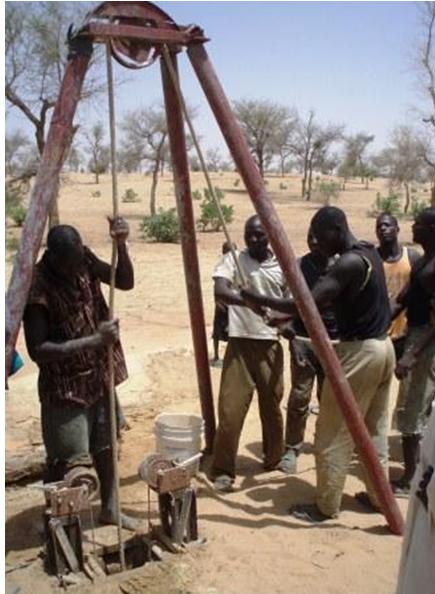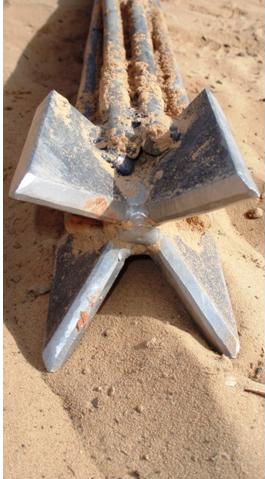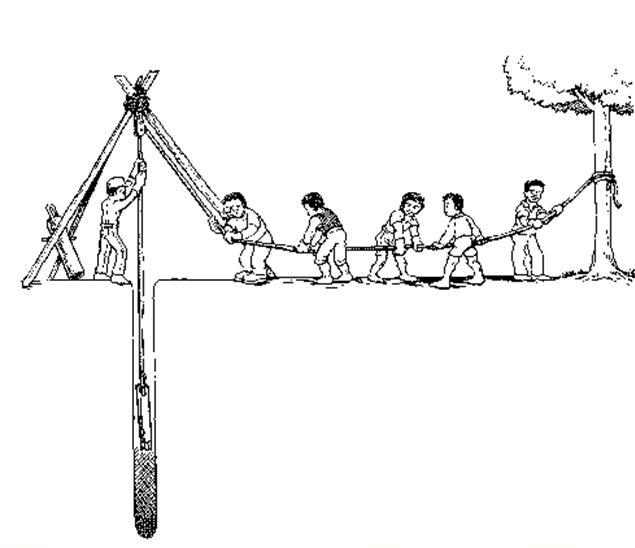冲击钻井
Percussion drilling is a manual drilling technique in which a heavy cutting or hammering bit attached to a rope or cable is lowered in the open hole or inside a temporary casing. The technique is often also referred to as 'Cable tool'. Usually a tripod is used to support the tools. By moving the rope or cable up and down, the cutting or hammering bit loosens the soil or consolidated rock in the borehole, which is then extracted later by using a bailer. Just as with hand augering, a temporary casing of steel or plastic may be used to prevent the hole from collapsing. When the permanent well screen and casing are installed, this temporary casing has to be removed.冲击钻井是一种人工钻井技术,需将较重的开凿钻头或锤击钻头连接在绳子或缆绳上,降到洞中或临时的套管里。这一技术通常也指“绳索钻具”。一般会运用三脚架支撑工具。通过上下拉动绳索,钻头将探孔内的土壤或固结岩击松,随后用泥浆泵将其抽出。就像使用手钻(hand augering)时那样,冲击钻井时可能会使用钢制或塑料的临时套管防止凿洞塌陷。永久的井管滤网和套管安装完成后,临时套管必须移除。
适宜条件
Percussion drilling is suitable for unconsolidated and consolidated formations: Sand, silt, stiff clays, sandstone, laterite and gravel layers.冲击钻井适用于下列疏松或固结的构造:沙、淤泥、硬黏土、砂岩、红土和砾石层。
Manual percussion drilling is generally used up to depths of 25 meters.人工冲击钻井通常用于最深为25米的井。
Before drilling starts, it is good to analyse where the water might be. There are lots of clues to look for in WellSpringAfrica.org's Selecting a Site.钻井开始前,最好先分析水可能在何处。非洲泉源组织的网站(WellSpringAfrica.org)上提供了许多表示有水源的指征线索。请选择网站。
| Advantages | Disadvantages |
|---|---|
| - Unlike any other drilling method, percussion can remove boulders and break harder formations, effectively and quickly through most types of earth. - Percussion drilling can in principle deal with most ground conditions. |
- The equipment can be very heavy and relatively expensive. - Especially in harder rock the method is slow (weeks, rather than days). |
Construction, operations and maintenance
Equipment is commercially produced in western countries. Local production is possible. Percussion drilling is hard work. Use of a small engine may be appropriate.
The percussion drill can be powered by hand, with several men pulling on a rope to lift and drop the bit, or it can harness the power of an engine. It can take the form of a few pieces that can be transported in the trunk of a car and carried into remote villages, or it can be mounted on the bed of a truck and driven to the drill site. The drill parts can be bought from the numerous world-wide companies that make drilling tools or they can be made from readily available scrap steel and local materials.
Suppliers
- Eijkelkamp Agrisearch Equipment - Drilling equipment and manuals on hand auger and percussion gouges.
- Van Reekum Materials - Drilling equipment, hand auger and percussion drilling.
Costs
For cost comparisons between hand drilling and percussion drilling: Wellspring Africa's Hand Powered Percussion Drill illustrates costs for materials, tools, and labour.
Field experiences
Percussion drilling is mainly used in Niger, Nigeria, Chad, Liberia, Ghana, Central America and western countries.
Manuals, videos and links
- Robert Vuik, Don de Koning and Arjen van der Wal. Percussion: Manual Drilling Series. Technical Training Handbook on Affordable Manual Well Drilling. Practica Foundation, June 2010. French version: FORAGE À LA PERCUSSION: Série forage manuel.
- Percussion Drilling. Different kinds of drills and connectors.
- Drilling Wells by Hand, Cliff Missen, Wellspring Africa, draft 4 - Manual on Percussion drilling, well construction, manufacturing tools. Website of WellspringAfrica
- KOEGEL, R. (1985) Self Help Wells, FAO Irrigation and Drainage Paper, FAO, Rome.ISBN 92-5-100398-X html version.
- CARTER, R. C. (2005) Human-Powered Drilling Technologies. an overview of human-powered drilling technologies for shallow small diameter well construction, for domestic and agricultural water supply , Silsoe College , Cranfield University , Bedfordshire, UK Download
- Drilling Boreholes for Hand pumps, Peter Wurzel, Skat, Switzerland, 2001 - A book on hydrogeology, well construction, drilling techniques, well development - Download. Website of SKAT
- Low-cost shallow tube well construction in West Africa, M. Sonau, FAO - An overview of shallow tube well drilling techniques - website. Website of FAO documents.
- Technical note 43. Simple drilling methods, Bob Elson and Rod Shaw, WEDC - An overview of simple drilling methods Download. Website of Loughborough University Technical Briefs section. Website of Loughborough University WELLS.
- A Water Handbook, Technical Guidelines Series, UNICEF, 1999 - Programming and implementation. Download.
- Technology notes, section 7; Tube wells and boreholes, WaterAid - An overview of human-powered drilling technologies. Download. Website of Wateraid.org.
- Water for the World, Technical note series rws 2, USAID 1982 - Technical notes on methods of developing of groundwater, manual drilling techniques. Website Livewater International. Under 'Cable Tool Wells'.
- Multi-service procedures for well-drilling operations, field manual chapter 9, US Military Chapter 9, alternative well construction, manual drilling techniques - Download.
Acknowledgements
- The basis for the material on this page was obtained from a desk study shortly to be published on the website of the Practica Foundation, and from the Rural Water Supply Network, and specifically its manual drilling section.
- 43. Simple drilling methods. WEDC.



